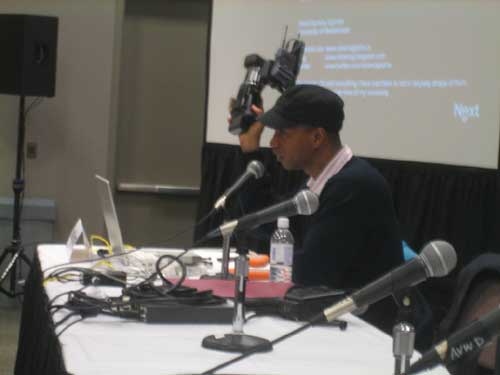At the Integrated Multimedia Video Journalism panel with David Dunkley Gyimah, British VJ(video journalist, lecturer and publisher of View Magazine.

Gyimah began his video career with BBC had a stint at Channel One as a VJ then back to BBC and is now a Lecturer and two years into a PhD study.
Gyimah defines VJ as “Simply it is the craft of one person producing a factual video story from the start to it being broadcast or going online.” Go here to read {a lot} more.
Gyimah said when he began with Channel 1 (a 24 hr news channel modeled after New York 1) in 1994 that the 25 odd VJs were very “Anti TV” and very much had the mindset that video journalism would replace traditional broadcast TV news because it had “so many assets that it couldn’t help but lead the future.”
He said they were met with network push-back with attacks like calling it “rubbish” because “one person can do it all.” The VJ model was very threatening to the unionized media professionals.
In 1996 the VJ revolution experienced burn out when “We realized that TV is not dead.” He compared his profession to the “X-Men of the news” as they were the outcasts among the journalism community.
Currently, the atmosphere has changed and with the advent of the Internet being turned to for news more often, there is a new rise in video journalism.
“When it comes to the net, there is no code yet as I believe that is set in stone,” said Gyimah. “We’ve all been taking TV’s language and applying that and it hasn’t quite worked. Video journalism needs a more cinematic- hightened visual base.”
He went on to explain that, “In a visual medium pictures drive the narrative. As a visual medium your pictures are king… You shoot with the edit in mind- when you’re shooting your story. You’re shooting the finished product.”
He says that a VJ should approach a project very focused and actually take very little video with possibly 40 minutes of video to 15 final minutes and all in short, quick cuts.
“It’s highly risky, but it’s doable.”
He said that a VJ should be so comfortable with their skills that shooting like this should be a natural as talking, in that you should be able to choose your shots and clips as quick as you would words and phrases as you speak.
He said it’s “about shooting the edit line.”
“You don’t need to shoot all that stuff,” he said. “Let the visuals drive the narrative”
He also explained that for video journalism to survive it has to be able to eek out stories that network news don’t cover or for some reason won’t cover.
He said that broadcast news are losing viewers and when news shows are changed to attempt to regain viewers its the graphic intro and the music that is changed while the story telling format remains the same.
Video journalism has an aesthetic movement derived from French new wave and has a free form film making quality to it that appeals to a younger viewer.

Permalink
Thanks for posting such a detailed summary on DDG’s talk-very useful for those of us unable to make it to texas!
Permalink